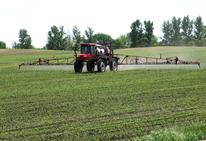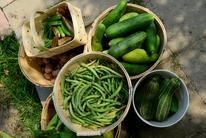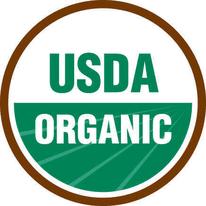By Constance Carlson and Kristine Moncada
Edited by Nicole Tautges, Gigi DiGiacomo, Craig Sheaffer and Jim Riddle
Nate and Amanda Nelson* met in college and came into farming somewhat unexpectedly. Nate grew up on a corn and soybean crop farm in central Minnesota, but was not encouraged to go into agriculture. Amanda did not grow up with an agricultural background, but her parents fostered a love in her for the outdoors and the natural environment.
After college, Amanda and Nate moved to the West Coast and lived there for a few years. Amanda worked in a position that used her design degree but also connected with the food movement. Her interest in farming grew and she decided that working an office job didn’t suit her. Nate shared this vision and together they decided to move back to Minnesota to be closer to family, build community connections and explore growing food as a career.
In the early years after their return to Minnesota, Amanda and Nate lived in the metro area and worked various agricultural jobs. It was while working as a farm manager for an organic CSA farm that Amanda gained the insight, skills, and confidence she needed to make the decision to become a farmer. Once they committed to farming, Nate and Amanda decided to relocate from the metro area to the town near Nate’s parents’ farm and rent farmland.
Back to the Land
For a few years, Nate and Amanda lived in town, rented, and commuted to their land. They started to build community connections and relationships, continuing to work other jobs as they established their farm and CSA market. Nate and Amanda grew a range of vegetables such as spring greens, tomatoes, root vegetables and winter squash for the 30 to 40 people who subscribed to a weekly share of produce.
After renting land and operating the CSA for several years, Nate and Amanda decided they were ready to purchase their own farm and produce food for their local community. One day, Nate’s dad pointed out an old 10-acre dairy farm in the area that was up for sale. It was conveniently located near their family, had a lovely farmhouse, and five tillable acres—a reasonable size to continue at the scale they were farming and also expand their enterprise to include more perennial crops such as apples, cherries and pears. They decided to buy the farm and become landowners.
Nate and Amanda had always incorporated pesticide-free farming practices in their production methods, even when they were renting. They did not pursue organic certification on their rented land for a few reasons, but mostly because they didn’t know if they would be on the land for the three years that were required for transitioning to organic. After they bought their land, however, Nate and Amanda considered the value of the certification for marketing their produce. Their customers already appreciated their pesticide-free practices, but Nate and Amanda recognized that organic certification would make them stand out from other producers in their region. Now that they were settled in one place, they decided to start the certification process.
Nate and Amanda had studied the requirements for organic transition and understood it was going to be a challenge for their new land. Although they had 40 feet of a grass-alfalfa-clover buffer between their farm and neighboring land, their farm was bordered on all sides by row crop farmers who used a regimen of herbicides and insecticides to manage weeds and pests. None of their closest neighbors were growing fruits and vegetables for direct markets and no one was organically certified. In their neighbors’ eyes, Nate and Amanda were not only new farmers, but also new farmers growing unusual crops using unconventional methods. They recognized that it was going to be important to build good relationships with their neighbors and to communicate carefully. Little did they realize that their relationship-building skills would be tested in the very first year on their land.
What to Do about Drift?
One day very early in the first season of their transition to organic, Amanda came home from her part-time work around lunch and spotted a tractor boom spraying a neighbor’s soybean field. It was a windy, hot, dry day. She shut her windows and watched the truck as it started to spray the southern field, just across the country road from their land. A gusty wind was blowing from the south across the fields. She watched the boom truck arm rising and rocking in the wind, creating an angle where the wind caught the herbicide and it appeared to drift toward their young tomato and pepper plants.
She called the neighbor to see what they were spraying and what their plan was for the field. It turned out to be glyphosate, which was a systemic broad-spectrum herbicide, meaning that it can kill most plants. She was told that the spraying was contracted with the local co-op and that complaints should be handled through them. Later that evening when Nate came home, they inspected the tomato, eggplant and pepper fields. It appeared as though the plants were okay.
However, a week later, the leaves and growth on Amanda and Nate’s eggplant and tomato plants started to look shriveled, stunted and unusual. They were not thriving and did not look like they should for the time of the growing season. It was concerning to Amanda and Nate. They realized they needed to call the co-op to report a problem and have their plants tested for pesticide application. As new young farmers to the area, Nate and Amanda were hesitant to make this call. They wanted to foster good relationships with their neighbors and didn’t want to create a conflict with them that might make farming in their community difficult.
At the same time, they were very concerned about how this potential drift might affect their transition plan. If a prohibited substance was found to have contaminated their field to a great degree, they might need to start over on the three-year time period of transition. They were also concerned about what to tell their CSA customers who had come to expect pesticide-free produce. Would their customers lose trust in them? Would they demand their money back?
There was a chance that the damage they were seeing was not from the pesticide spray. Organic farms are required to have strips of land, called buffers, between their fields and non-organic land to protect from prohibited substances. At 40 feet wide, their buffer between the fields was quite significant and should have been sufficient to protect their crops under most conditions. However, they couldn’t explain the damage to their plants. A pesticide test would be the only way to conclusively determine whether or not drift damage had occurred.
Nate and Amanda knew they had to do something about the suspected overspray problem, even though it might open a conflict with their neighbors. Although they had decided to start the process of organic transition for their farm, they hadn’t started working with an organic certifier yet, so they turned to a farm business mentor they had known for a few years. This person recommended that Nate and Amanda call the co-op that did the spraying.
The co-op forwarded the issue to their agronomist who eventually called back and arranged an on-farm visit. The co-op sent a specialty crop person to take samples to test for herbicides. The co-op let Nate and Amanda know a week later that their samples indicated pesticide drift. The co-op compensated them for the loss of their plants due to herbicide drift.
Nate and Amanda could see that their tomatoes and eggplants were going to be a total loss. They salvaged the crops not affected by drift and decided to delay their organic transition by a year. They were committed to becoming certified organic and this event brought home the fact that they needed to start working with an organic certifier and have a plan to protect themselves from this happening again.
There are various ways to try to prevent damage from drift – physical (such as modifying buffers), social (such as communicating with neighbors) and cultural (such as timing planting of sensitive crops). What steps should Amanda and Nate take to protect themselves and their organic production from pesticide drift in the future?
* While these cases describe actual situations, names and other identifying details have been changed to protect the identity of participants.
Access the complete decision case study with all educational materials (pdf) >>>
You may cite this publication as:
Carlson, C. and K. Moncada.2017.Sharing a Fenceline: Keeping the Peace when Pesticide Drifts. A Decision Case Study in Principles for Transitioning to Organic Farming: e-Learning Materials and Decision Case Studies for Educators. C. Sheaffer, G. DiGiacomo, J. Riddle, and N. Tautges (Eds). University of Minnesota, St. Paul, MN.



